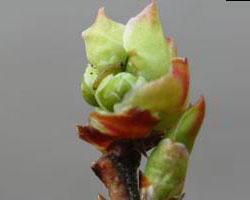Winter Moth (Operophtera brumata): This is a new and important pest of apples, blueberries and other deciduous plants, especially in Southeastern New England. They can severely reduce yields and/or defoliate bushes. Moths emerge from the soil usually in late November and may be active into January. The male moths are light brown to tan in color and all four wings are fringed with small elongated scales that give the hind margins a hairy or fringed appearance. The female is gray, almost wingless and, therefore, cannot fly. Females are usually found at the base of trees or scurrying up tree trunks. Winter Moth caterpillars are pale green with a white longitudinal stripe running down both sides of the body. They are "loopers" or "inchworms" and have just 2 pairs of prolegs. At maturity, the caterpillars will be approximately one inch long, whereupon they drop to the soil for pupation. Pupation occurs from late May into early June. Winter moth caterpillars are often found in association with both the fall and spring cankerworms, which look and have similar feeding patterns to the winter moth caterpillar.
Life Cycle: After mating, the female deposits eggs loosely in bark crevices, under bark scales, under lichen, or elsewhere. The adult moths then die and the eggs over-winter. Eggs are dark-colored at first but turn orange within 3-4 weeks. In March, just prior to hatching, they turn red and eventually a deep, shiny blue just prior to hatching. Eggs hatch when temperatures average around 55˚F. It is believed that egg hatch in Massachusetts occurs when 20 Growing Degree Days (GDD) base 50˚F have accumulated, which is historically during the second week in April but earlier if temperatures are atypically warm. (Another model predicts egg hatch at 173 GDD base of 40˚F starting Jan 1). This means that egg hatch occurs just at or right before bud break of most of the host plants. After hatching, the larvae wriggle between bud scales of newly swelling buds of such hosts as: maple, oak, ash, apple, crabapple, blueberry, cherry, etc. and begin feeding.
See http://newa.cornell.edu/ to calculate the Growing Degree Days for your location.
Damage: Caterpillars feed within both flower and foliar buds. Once a bud has been devoured from within, the caterpillar will migrate to other buds and repeat the process. Destruction of the flower buds leads to greatly diminished harvest on fruit crops. Older larvae feed in expanding leaf clusters and are capable of defoliating trees and other plants, when abundant.
Management: A dormant oil spray to the trunks and branches of bushes may be helpful to kill the overwintering eggs before they hatch. However, some eggs are under bark flaps and loose lichen and may be protected from oil sprays. Caterpillars may also invade host plants by ballooning onto them from surrounding trees after treatment has been applied. Several insecticides are labeled for use against either Winter Moth or Spanworm and are outlined in the table below.
Dormant: Dormant Oil, 2-2.5% plus Esteem 35WP or Confirm 2F or Asana XL
Bud Swell: Dormant Oil, 2-2.5% plus Confirm 2F or Delegate or Assail 70WP or Asana SL or Esteem 35WP
Bud Break: Confirm 2F or Delegate or Asana XL or Esteem 35WP
Additional information and recommendations on the Winter Moth
Where brand names for chemicals are used, it is for the reader’s information. No endorsement is implied, nor is discrimination intended against products with similar ingredients. Please consult pesticide product labels for rates, application instructions and safety precautions. Users of these products assume all associated risks.
